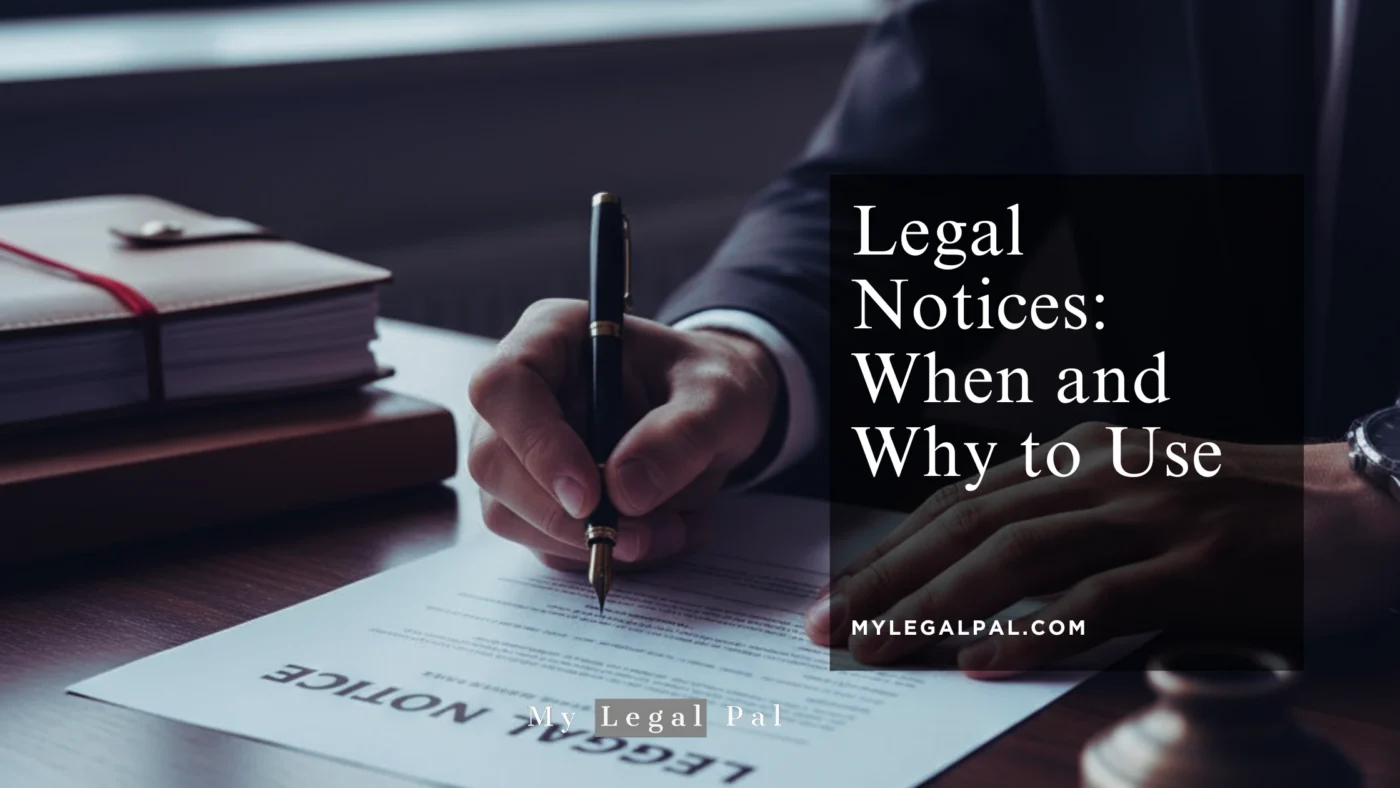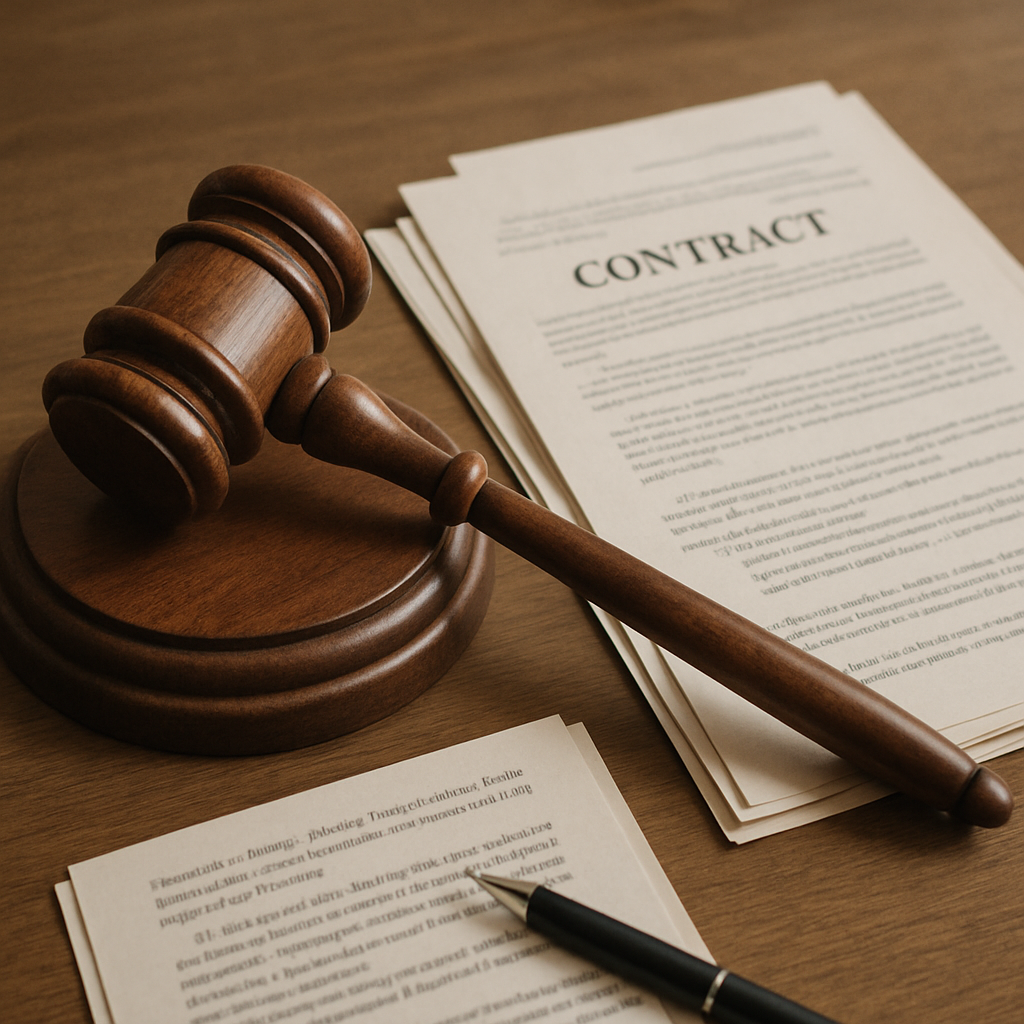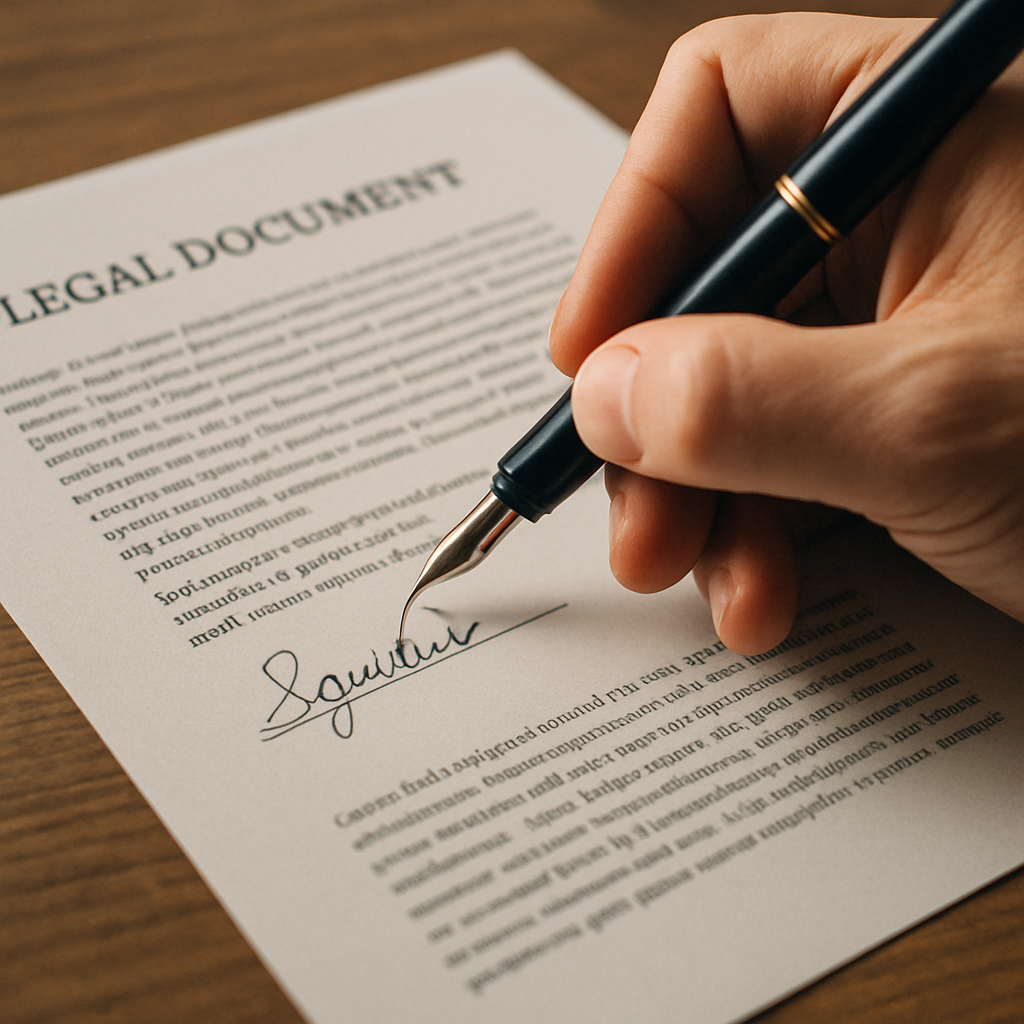Legal notices are essential tools in the legal world. They serve as formal communications to address disputes or claims.
Understanding when and why to use them is crucial. They can prevent misunderstandings and protect your rights.
A legal notice is often the first step in resolving conflicts. It can lead to a settlement without going to court.
Different situations require different types of legal notices. For instance, recovering money or addressing a bounced cheque.
Knowing how to draft and send a legal notice is important. You can even do it without a lawyer.
What is a Legal Notice?
A legal notice is a formal communication. It alerts an individual or entity of your intention to take legal action. This serves as a warning or a final chance to resolve a dispute outside court.
A well crafted legal notice outlines your concerns clearly. It specifies the issues at hand and the demands for resolution. It can relate to unpaid debts, contract breaches, or property disputes.
The recipient of a legal notice should take it seriously. Ignoring it could lead to legal proceedings. The notice often prompts quicker resolutions and negotiations.
Key elements include:
- Clear identification of both parties
- Facts and details of the issue
- Specific demands for resolution
- A deadline for compliance
A written legal notice can help preserve your legal rights. It documents your attempts to resolve the issue amicably.
Importance of Legal Notices
Legal notices play a crucial role in dispute resolution. They serve as a formal warning. This helps both parties address and potentially resolve issues before they escalate to court.
One major benefit is preserving legal rights. A legal notice clearly states your position and demands. This documentation becomes useful if you need to proceed to legal action.
These notices often prompt quicker settlements. The recipient understands the seriousness of the situation. It may encourage them to engage in negotiations to avoid costly litigation.
Legal notices offer several advantages:
- Establish a documented trail of your grievances
- Provide a chance for amicable settlement
- Clarify possible legal actions to the recipient
- Define a clear timeline for resolution
Ultimately, they enhance clarity and communication. This aids in resolving conflicts without court intervention. Understanding their importance can lead to smoother resolutions.
Common Situations Requiring Legal Notices
Legal notices are versatile tools in various situations. Many conflicts benefit from formal notice before any legal action. Addressing issues early can prevent lengthy disputes.
- One common scenario is when payment is overdue. Businesses often use legal notices to urge clients to settle outstandin g invoices. This formal approach can prompt quicker payment.
- Landlord-tenant disputes often require legal notices. Whether it’s for unpaid rent or violating lease terms, a notice sets the stage for resolution. It communicates any necessary corrective actions.
- Breach of contract is another frequent situation. If one party fails to honor an agreement, a legal notice can demand compliance or compensation. It serves as an official warning.
- Family disputes can also call for formal notices. Matters like child support or property divisions benefit from clarity. Legal notices establish expectations and can reduce misunderstandings.
Here are situations where legal notices are invaluable:
- Overdue payments or invoices
- Landlord-tenant disagreements
- Breach of contract issues
- Family disputes and settlements
These examples illustrate the utility of legal notices. They address diverse issues effectively. Implementing them wisely can safeguard your interests.
Legal Notice for Recovery of Money
Recovering owed money can be frustrating and time consuming. Utilizing a legal notice accelerates the process. It formally informs the debtor of their obligations.
Crafting a precise legal notice is crucial. It should clearly state the amount owed and any related terms. This eliminates ambiguity, ensuring the debtor understands their duty.

Legal notices often include a deadline for payment. This puts pressure on the debtor to act swiftly. It also demonstrates seriousness and intent to pursue legal avenues if ignored.
Sending a legal notice might not guarantee immediate repayment. However, it serves as solid evidence in court if further action becomes necessary. Preparing a meticulous document strengthens your case.
Consider these key components when drafting a notice:
- Name and address of the debtor
- Total amount owed and due date
- Details of the initial agreement or contract
- Consequences of non-payment
Understanding these elements can improve your notice’s effectiveness. Properly structured legal notices demand attention and quick resolution. They provide a professional method to claim what you are rightfully owed.
Recovery Money Legal Notice Format
Drafting an effective legal notice for recovering money requires a specific format. This ensures clarity and professionalism. Following a structured format is vital.
Start with a formal salutation and introduce yourself or your company. State the purpose of the letter clearly. Mention the specific amount owed and link it to a previous agreement or transaction.
Outline a timeline for repayment. Provide a deadline by which you expect the debt settled. Specify the legal actions you will pursue if the payment isn’t made by this date.
Here’s a simple format guide:
- Salutation and introduction
- Clear statement of owed amount
- Reference to original debt agreement
- Deadline for payment with consequences of non-payment
Including these elements makes your notice compelling. It’s professional and leaves no room for confusion. This structured format increases the likelihood of receiving your money promptly.
Sample Legal Notice for Recovery of Money
Here is a sample notice for recovering funds. It demonstrates how to structure each section properly. This sample aids in visualizing an effective notice.
[Your Name/Company Name] [Your Address] [Date]
[Debtor’s Name] [Debtor’s Address]
Subject: Demand for Payment of Outstanding Debt
Dear [Debtor’s Name],
I am writing to remind you of the amount of [amount] owed as per our agreement dated [agreement date]. The payment was due on [due date] and remains unpaid.
Please remit payment by [specified deadline]. Failure to do so may result in legal action for recovery, including court proceedings. It is in your best interest to settle this debt promptly.
Thank you for your immediate attention to this matter.
Sincerely, [Your Name]
When you use this sample, tailor it with relevant details. This ensures your specific situation is aptly addressed. Following this guide can help speed up the repayment process.
Legal Notice for Cheque Bounce
A bounced cheque can lead to significant financial and legal problems. Sending a legal notice is often the first step in addressing this issue. It formally requests the issuer to honor their commitment.
A cheque bounce occurs due to insufficient funds or other banking errors. Regardless of the reason, the issuer should be notified promptly. A legal notice acts as a formal demand for payment.

When drafting this notice, it’s important to be clear and concise. The notice should mention the cheque number, amount, and bank details. This specificity leaves no room for confusion.
Using a legal notice creates a sense of urgency. It emphasizes the potential legal consequences of failing to pay. This often encourages the issuer to resolve the matter swiftly.
Key points to include in your legal notice are:
- Details of the bounced cheque
- Date of cheque issuance and amount
- Reason for the cheque bounce
- Deadline for payment to avoid further action
Issuing a legal notice can often prompt a prompt response. It elevates the seriousness of your claim and is an essential step in cheque recovery processes.
Sample Legal Notice for Cheque Bounce
Below is a sample legal notice for a cheque bounce. This example aims to guide you in drafting your notice effectively.
[Your Name/Company Name] [Your Address] [Date]
[Issuer’s Name] [Issuer’s Address]
Subject: Legal Notice for Cheque Bounce
Dear [Issuer’s Name],
I write to bring to your attention the bouncing of cheque number [cheque number] dated [date]. This cheque, amounting to [amount], was returned due to [reason for bounce].
You are kindly requested to remit the outstanding amount within [specified deadline]. Failure to comply may result in legal proceedings under the Negotiable Instruments Act. It is crucial to fulfill your obligation and avoid additional legal consequences.
Please treat this notice as urgent and oblige by remitting the specified amount promptly.
Best regards, [Your Name]
Ensure your notice contains all necessary details to make it clear and authoritative. Modify it with your specific data for relevance. By following this template, you can communicate your case effectively.
How to Send a Legal Notice Without a Lawyer
Sending a legal notice can seem daunting, especially without a lawyer. However, understanding the process simplifies it. A well-drafted notice can often suffice.
First, gather all pertinent information and documents. These may include contracts, transaction records, or communication exchanges. Reliable documentation is crucial.

Next, draft the notice clearly and concisely. Your notice should state the purpose, and include the necessary details. Avoid complex legal jargon for clarity.
Consider these essential elements when drafting your notice:
- Identification of parties involved
- Clear statement of facts and issues
- Demand for specific relief or response
- Deadline for taking action
It’s important to remain professional and respectful. Politeness in tone does not undermine the seriousness of your request. It may facilitate a more amicable resolution.
After drafting, send the notice through a reliable method, such as registered mail. This provides proof of delivery, ensuring your notice is acknowledged. With these steps, you can effectively send a legal notice without hiring a lawyer.
Steps to Draft and Send a Legal Notice
Drafting a legal notice involves careful planning and attention to detail. The steps are straightforward once you understand them. Here’s how to proceed.
Begin by clearly identifying the recipient. This includes full names, addresses, and contact information. Ensuring accuracy is essential to prevent any misdirection.
The body of the legal notice should be comprehensive yet concise. Clearly outline the facts and specify the demand or action required. Be precise about dates, amounts, and obligations.
Consider the following checklist to ensure nothing is missed:
- Parties’ full details
- A detailed account of facts
- Clear demand or remedy
- Specific deadline or time frame
Review your notice for errors or ambiguities. An error-free document bolsters its credibility. Then, select a trusted delivery method. This could be registered mail, courier, or electronic delivery, always ensuring verifiable receipt.
Finally, maintain copies of all documents for your records. This may include both drafts and delivery confirmations. With thorough preparation and precision, drafting and sending a legal notice is effectively manageable.
What Happens After Sending a Legal Notice?
Sending a legal notice sets a formal process in motion. The recipient must respond by a specified deadline.This step signifies the beginning of legal communication.
Upon receipt, the recipient has several options. They can comply with the demands or negotiate terms. Ignoring a legal notice often worsens the situation.
Typical outcomes after sending a legal notice include:
- Compliance with the terms outlined
- Counter-offer or negotiation
- Complete rejection of the notice
- Initiation of legal proceedings
It’s crucial to track the recipient’s response. If the notice goes unanswered, legal action can be initiated. Properly documenting each step builds a strong foundation for any future legal steps.
Conclusion
Legal notices play a crucial role in resolving disputes. They serve as a formal way to communicate issues and demands clearly. Using them effectively can prevent court battles.
Understanding the process is essential. Every step, from drafting to sending a legal notice, carries importance. It’s vital to follow the correct format and deadlines.
Seeking professional advice or conducting thorough research can aid the process. A well-crafted legal notice can save time and money. It’s a powerful tool in the realm of law.
Visit My Legal Pal to send Legal Notice for any situations before taking legal laction.



